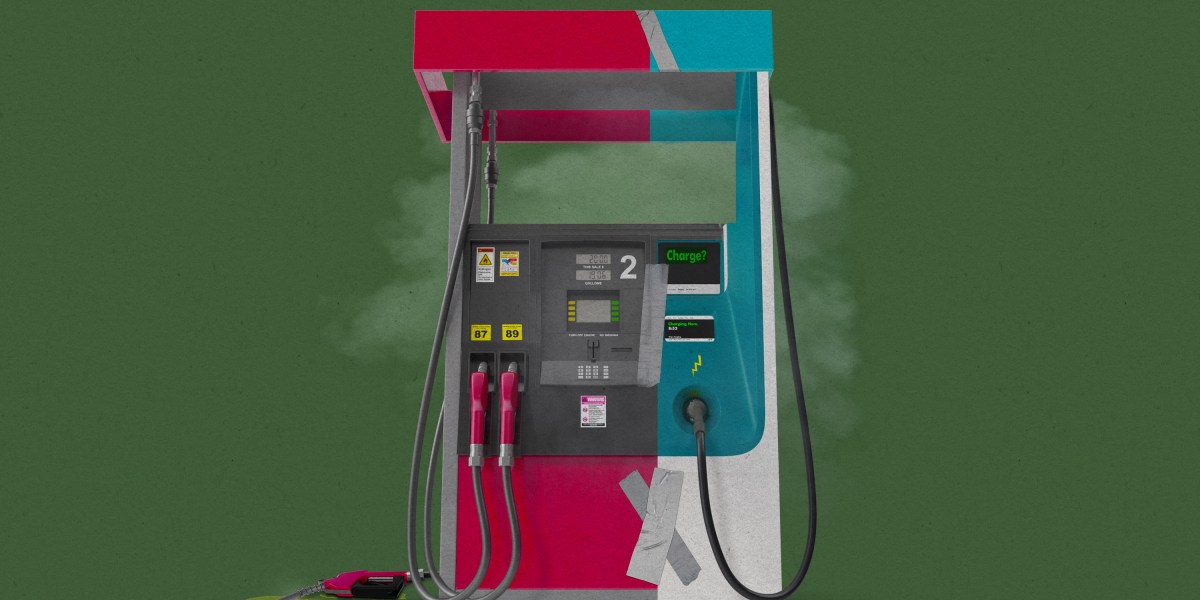The problem with plug-in hybrids? Their drivers.
Plug-in hybrids are supposed to be the best of both worlds—the convenience of a gas-powered car with the climate benefits of a battery electric vehicle. But new data suggests that some official figures severely underestimate the emissions they produce.
According to new real-world driving data from the European Commission, plug-in hybrids produce roughly 3.5 times the emissions official estimates suggest. The difference is largely linked to driver habits: people tend to charge plug-in hybrids and drive them in electric mode less than expected.
“The environmental impact of these vehicles is much, much worse than what the official numbers would indicate,” says Jan Dornoff, a research lead at the International Council on Clean Transportation.
While conventional hybrid vehicles contain only a small battery to slightly improve fuel economy, plug-in hybrids allow fully electric driving for short distances. These plug-in vehicles typically have a range of roughly 30 to 50 miles (50 to 80 kilometers) in electric driving mode, with a longer additional range when using the secondary fuel, like gasoline or diesel. But drivers appear to be using much more fuel than was estimated.
According to the new European Commission report, drivers in plug-in hybrid vehicles produce about 139.4 grams of carbon dioxide for every kilometer driven, based on measurements of how much fuel vehicles use over time. On the other hand, official estimates from manufacturers, which are determined using laboratory tests, put emissions at 39.6 grams per kilometer driven.
Some of this gap can be explained by differences between the controlled conditions in a lab and real-world driving. Even conventional combustion-engine vehicles tend to have higher real-world emissions than official estimates suggest, though the gap is roughly 20%, not 200% or more as it is for plug-in hybrids.
The major difference comes down to how drivers tend to use plug-in hybrids. Researchers have noticed the problem in previous studies, some of them using crowdsourced data.
In one study from the ICCT published in 2022, researchers examined real-world driving habits of people in plug-in hybrids. While the method used to determine official emissions values estimated that drivers use electricity to power vehicles 70% to 85% of the time, the real-world driving data suggested that vehicle owners actually used electric mode for 45% to 49% of their driving. And if vehicles were company-provided cars, the average was only 11% to 15%.
The difference between reality and estimates can be a problem for drivers, who may buy plug-in hybrids expecting climate benefits and gas savings. But if drivers are charging less than expected, the benefits might not be as drastic as promised. Trips taken in a plug-in hybrid cut emissions by only 23% relative to trips in a conventional vehicle, rather than the nearly three-quarters reduction predicted by official estimates, according to the new analysis.
“People need to be realistic about what they face,” Dornoff says. Driving the vehicles in electric mode as much as possible can help maximize the financial and environmental benefits, he adds.
It’s important to close the gap between expectations and reality not only for individuals’ sake, but also to ensure that policies aimed at cutting emissions have the intended effects.
The European Union passed a law last year that will end sales of gas-powered cars in 2035. This is aimed at cutting emissions from transportation, a sector that makes up around one-fifth of global emissions. In the EU, manufacturers are required to have a certain average emissions value for all their vehicles sold. If plug-in hybrids are performing much worse in the real world than expected, it could mean the transportation sector is actually making less progress toward climate goals than it’s getting credit for.
Plug-in hybrids’ failure to meet expectations is also a problem in the US, says Aaron Isenstadt, a senior researcher at the ICCT based in San Francisco. Real-world fuel consumption was about 50% higher than EPA estimates in one ICCT study, for example. The gap between expectations and reality is smaller in the US partly because official emissions estimates are calculated differently, and partly because US drivers have different driving habits and may have better access to charging at home, Isenstadt says.
The Biden administration recently finalized new tailpipe emissions rules, which set guidelines for manufacturers about the emissions their vehicles can produce. The rules aim at ramping down emissions from new vehicles sold, so by 2032, roughly half of new cars sold in the US will need to produce zero emissions in order to meet the standards.
Both the EU and the US have plans to update estimates about how drivers are using plug-in hybrids, which should help policies in both markets better reflect reality. The EU will make an adjustment to estimates about driver behavior beginning in 2025, while the US will do so later, in 2027.



![Türkiye Humanitarian Needs and Response Overview – Interim Update (Published 11 April 2023) [EN/TK] – Türkiye Türkiye Humanitarian Needs and Response Overview – Interim Update (Published 11 April 2023) [EN/TK] – Türkiye](https://reliefweb.int/sites/default/files/styles/large/public/previews/8e/65/8e65a6e3-9df1-4af0-89c2-2d6083093d3c.png)
